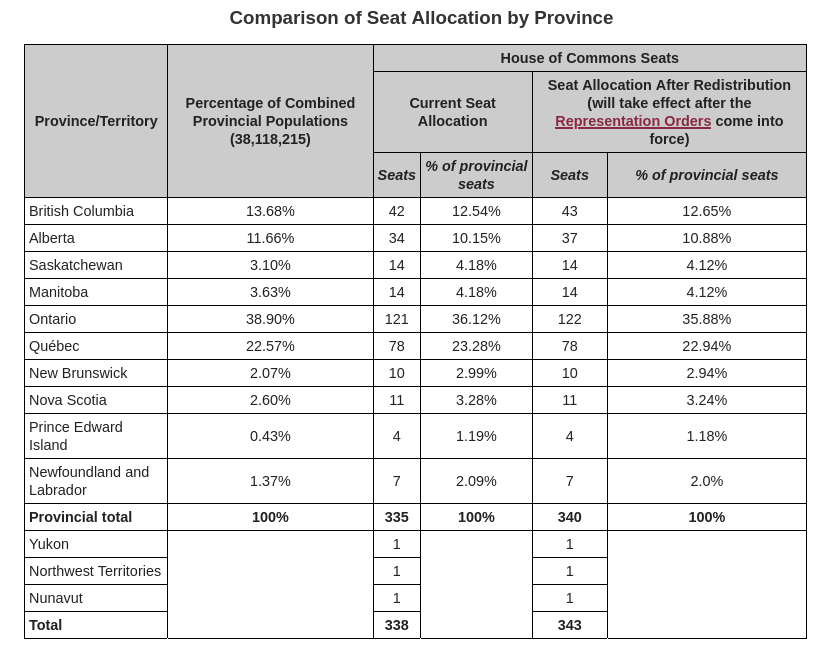Currently, we vote for one representative per riding. The issue with that is that (hypothetically) one riding could have a million people and another could have 100 people. But both of them would have the same amount of power in Parliament because 1 riding = 1 mp.
How would that work in a proportional election system? Is there one candidate per X number of citizens in an area? Wouldn’t cities be over represented? Wouldn’t there be one candidate to cover very large sparsely inhabited areas that might not have the same needs from one spot to another?
I’m really curious how this would be implemented.
I think a common way to implement PR is to have 1 riding = 2 mp. Half the MPs are elected as local representatives, and the other half are appointed to balance out the seats to match (as closely as possible) the popular vote.
It depends on how it is implemented. There are many examples out there. wikipedia list of electoral systems by country
A pure proportional voting would have no ridding/districts, I think this is more common for municipal and provincial level elections.
If the countries are divided into independent-ish states or provinces, they can divide the population by the number of available seats - that means a province with 10% of the population, ideally would have close to 10% of the seats.
I am not a big fan of breaking down provinces further because the more you divide into smaller districts, more votes are thrown away, and you open it up for gerrymandering.
Canada seems to do a good job dividing seats per province, the problem is that the provinces break it down into districts and use first past the post voting to elect officials.
First, the largest electoral district in 2021 was Edmonton-Wetaskawin, with 209, 431. The smallest was Labrador with 26,655. Elections Canada does try and even out the sizes of the ridings in population, but that is only one of several considerations, but still a smaller gap than 1,000,000 and 100. But your point does still stand, in that this could be seen as a problem with our pure FPTP system. Labrador voters have around 8 times the say Edmonton voters do. To be fair, the extremes narrow pretty fast and do converge fairly solidly around the 70-110k range.
So as to how that would change in some sort of PR system… it depends.
First, do you keep 338 seats in Parliament? Are they all going to be tied to ridings or will you be using some sort of list-based PR system? I’ll use two examples, STV and MMP, since they are more well know.
Single Transferable Vote (STV) would group several smaller ridings together to form larger multicandidate ridings. Voters rank the candidates numerically. The least popular candidates are dropped sequentially until Depending on how you want to divide up and group the ridings and how big you want them is pretty much open. Typically, I don’t think you want more than 7 candidates or it gets confusing, and in much of Canada you already have big ridings. Plus population centres can skew things. Do you make all of Vancouver Island a bigger 7 seat district, or do you break Victoria out into it’s own 4 seater and the rest of Vancouver Island a 3 seater? The Territories each have one riding that is pretty darn big, and already much smaller than average (all three would make a single average sized riding). You could just have single seaters, so basically exactly what we have now but with IRV (Instant Runoff Voting). Better than FPTP, but not very proportional
Mixed Member Proportional would keep the single seat ridings and add “top-up” seats assigned from party lists, or have fewer bigger ridings to free up seats to be assigned from party seats. Voters would vote for their local candidate as currently, and local candidates are assigned as under FPTP. The voters might also mark a party preference which would be used to assign the makeup seats, or the vote for the local candidate would be also used to indicate party preference. Or there could also be an open list.
So I guess the final answer is it depends. And balancing people vs. area is already a problem, and although a new voting system might solve some of those problems, you are going to have disagreements on what the problem even is. Arguably using some flavour of MMP the most “fair” (for some definitions of fair) since even if Labrador’s 26,000 people have way more say than Edmonton-Wetaskawin’s 209,000, it will pretty much all come out in the wash since their votes will be evened out in the make-up seats assigned by party list.
Also, this is not exhaustive. There are other systems and tweaks to systems (q.v. RUP, Rural-Urban Proportional ) that could work even better for Canada federally.
Another common way is to have each riding represented by multiple MPs, which are then split up between parties in proportion to their vote share. The number of MPs representing a riding can also be proportional to its population, so a rural riding will have 5 MPs but a city might have 20.
(See this map)


Well, MMP breaks down when you realize you need to define geographic areas of ridings that you need to lump together so that you can get the ratios right. An example elsewhere in the post points out lumping Victoria’s 4 seats and the rest of Vancouver Island’s 3 seats. If all lumped together, you can get the ratios of actual votes to match the representations of the MPs pretty good - but ultimately someone has to sort of ‘fix it in post.’ If 80% vote for party X in all 7 ridings (which, without looking at the data, I will concede in advanced has never bloody happened) you’re going to take one of those ridings and hand it off to an MP that didn’t win to represent the collective 15-20% that voted the second place party that might be popular there. Which riding gets the MP not elected in the riding? Of course, we need to keep ridings because the population density is very skewed in Canada. If you take a look where people live, you’d realize without ridings, in a true PR setting, the Windsor-Québec City corridor would forever run the rest of Canada. Why try to get votes anywhere else? Do you really want to give Alberta another reason to say that Ottawa has no mandate in their province?
Another option is to drastically increase MPs (that seems like a terrible idea) so that if the riding is 55% for party X and 45% for party Y, you can have 2 MPs from both parties and not add any advantage to anyone to help in forming government. It would almost be a better idea to have a run-off vote until you reach a true majority instead of a plurality in a riding.

That’s kind of the problem I wanted to raise with this question. Some areas have a much higher population density than others. They’ll basically be running the country as you said.
But then again, if the majority of Canadians live there, wouldn’t they be better represented at the parliament? Wouldn’t decisions then be made to better represent the majority?
Housing is a major issue in densely populated areas. Shouldn’t there be more push to tackle this problem for example?
That’s why there’s a difference in riding sizes… 1 vote per person shouldn’t mean that Windsor-Québec should decide fishery issues for Newfoundland… So a riding on the rock has less people, because it has unique needs based on its location and geography that might be better served by giving them more of a say than ridings in London Ontario, which might have very similar needs across the city. In essence, more people don’t necessarily mean more unique issues. There’s a limit to that of course - but the general ‘needs’ are outlined by law and adjusted without gerrymandering - which is not terrible, but maybe could be improved with more representation in the dense ridings - after all, there’s increase concerns within the cities these days.



